
Imagine your home. Imagine your bedroom, your kitchen, your garage door and your family. Now imagine what your life would be like if water rushed into the entire city and you lost everything. Everything you once knew was completely gone, your school, house, neighborhood, were all demolished.
Seven students and two faculty and staff members traveled to New Orleans this past week to help rebuild a house for a family who suffered from Katrina. We stayed at Camp Hope, which is a non-profit organization whose mission is to serve those dedicated to serving the communities of Greater New Orleans. We slept and ate there every day and then went to work at the St. Bernard Project for four days, where we helped put flooring in, painted, cut shoe and caulk.
I always thought I knew what happened to New Orleans when Hurricane Katrina hit, but that was extremely false.
The man who cooked dinner every night at Camp Hope told us that, “A house would have to be built every day for the next 76 years, in order to rebuild the entire city of New Orleans.”
That means that 27,740 houses still need to be rebuilt after the deconstruction of Hurricane Katrina.
The hurricane itself is the first and most obvious to blame for all of the problems that Katrina endured, but reality is that the problems were around much earlier before the levees broke.
We worked on the first day at the house on Pleasure Street and went to the levees. I thought being there in that moment was pretty sad and eerie. I cannot imagine all of those innocent lives that were affected.
There were times where I totally questioned if what we were doing was even worth it. The reason is because you would think that after over 1,500 people died because of a problem that could have been totally preventable, that houses would be lifted higher and the levees would be rebuilt to the best quality possible.
Honestly, I think it was a really bad cleanup job. It did not seem like the levees now are any better, and about 200 feet behind them are brand new houses.
But it is pretty incredible. Just being able to work with people who care so much about making a difference in the community, is incredibly inspiring. The culture as is, is really relaxed and kind, but Katrina really brought the community together.
You cannot just decide to do something on your own and you really need to work together to find common ground.
I think I definitely want to lobby and advocate more. I think that this experience has solidified my desire to do a year of service. Where that would be? I am not exactly sure where that may be, but now I have a better understanding of short-term service trips. We can always learn more, even with our own passions and beliefs.
We became a community at St. Bernard Project and at Camp Hope and it will be something I will never forget.



